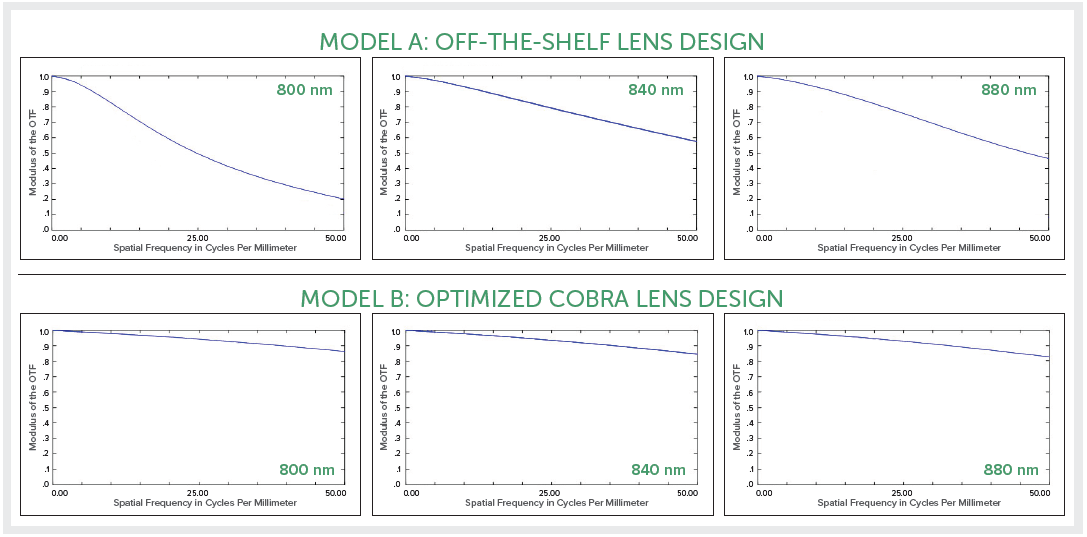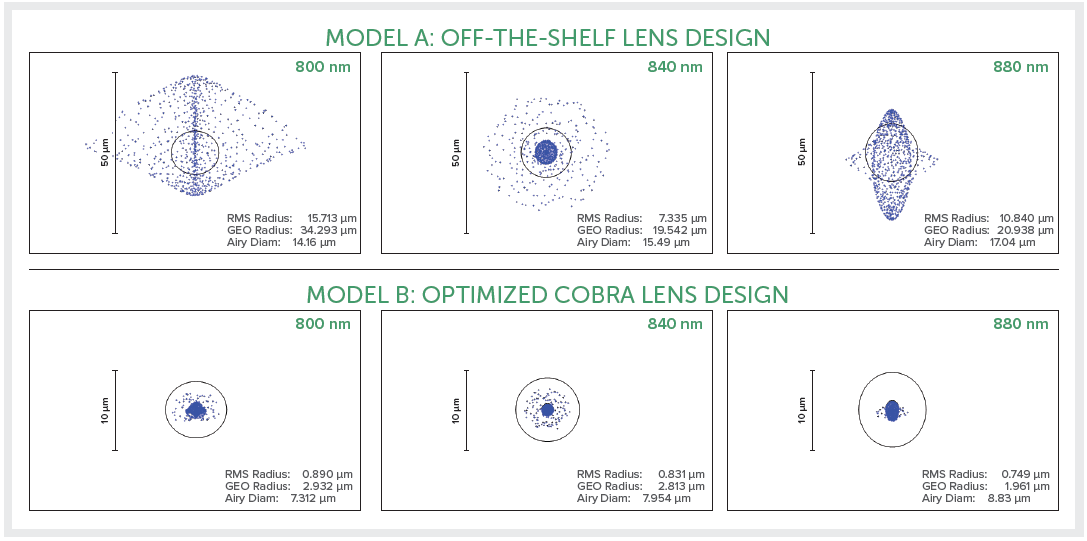When you ask the question, how does a spectrometer work? Almost anyone who works in optics will tell you – it divides a beam of light into its elemental colors or wavelengths for quantitative or qualitative analysis of the incoming light’s spectral composition. But what makes a great OCT spectrometer? That answer is less trivial.
UV, VIS, NIR, and Raman spectrometers are common tools used for identification, characterization, and quantification of substances in many areas of research and industry. OCT spectrometers are less widely known and understood, though they use many of the same optics.
Someone working in the field of optics can likely tell you that OCT is a common optical imaging technique recognized for its speed and high-sensitivity and is now a cornerstone in ophthalmic diagnostics. They may even know that there are two primary approaches to OCT: SS-OCT, which utilizes a swept wavelength source and a single element detector, and SD-OCT, which utilizes a broadband source and a spectrometer for detection.
However, if you ask them to merge the two topics of spectroscopy and optical coherence tomography and advise you on what type of spectrometer is best for OCT, you may not get much detail other than some simple comments regarding resolution, speed, and sensitivity.
The reality being that performance has to do with multiple factors, including resolution, SNR, and a property that may be somewhat cryptic to the spectroscopist - roll-off.
OCT: A Brief Introduction
OCT is dependent on low-coherence interferometric measurements. In the first wave of OCT devices, this was conducted by positioning the reference mirror arm of an interferometer, stationing the sample in the other arm and scanning the reference arm through different time points (depths) within the sample.

Low coherence interferometry of infrared light is used to estimate the time of flight, quantifying depth and providing micron-level resolution.
A cross-sectional image of structure could be created as interference between the sample and reference arms carried with its information about the degree of scattering at different depths.
However, researchers soon understood a more efficient way to acquire the same information was by analyzing the light at various wavelengths rather than at different time points (i.e., spectral-domain interference vs time-domain interference). While this modification in the approach provides an exponential increase in speed and sensitivity, an analysis of the various wavelengths requires a spectrometer suitable for the task.
Thus, the requirements and standards for a good OCT spectrometer vary considerably when compared to a standard spectrometer used for direct spectral analysis of absorbance, fluorescence, or Raman. It is necessary for OCT spectrometers to work at exceptionally rapid speeds in comparison to standard spectrometers. This is to enable the creation of 2D or 3D images in a sensible amount of time.
Light reflected back from an OCT sample can also have distinct polarization modes, and thus it is also crucial to maintain as little dependence on polarization as possible. This is a difficult challenge for spectrometers which incorporate a reflective grating in their design, as a specular reflection from a blazed grating surface intrinsically favors s-polarization.
It is also vital to understand that an OCT scan is not in search of the location of a spectral peak or the relative or absolute intensity of a spectral band, but rather it seeks an interference pattern reported in the spectral domain. This makes the resolution of the spectrometer a crucial performance parameter. Specifically, an OCT spectrometer has limited tolerance for light leaks from one pixel into other nearby pixels. If such an occurrence takes place, there will be a loss of sensitivity in the image as a function of depth.
Roll-off in OCT: Losing Sensitivity with Depth
Signal-to-noise roll-off or fall-off refers to the loss of sensitivity in OCT as a function of depth, which in turn relates to a progressive decay in sensitivity as a function of depth. Roll-off is fundamentally a result of the loss of fidelity of the interference pattern. Each separate pixel detecting light in the spectrometer corresponds to a small range of wavelengths rather than just one specific wavelength. However, a perfect interference effect requires measurement of a single, infinitely narrow wavelength. The figure below illustrates a typical example of loss in sensitivity vs the depth of measurement for a Wasatch Photonics OCT spectrometer with 1600 nm central wavelength.

The problem is exacerbated by the spread of wavelengths to neighboring pixels because of the finite resolution of the spectrometer. While the first issue is fundamental, the second one can be carefully managed via the appropriate design of the spectrometer optics. Cross talk between the camera (detector) pixels, a property of the camera itself, also accentuates the roll-off in a spectrometer. Therefore, selecting a suitable camera (detector) becomes even more important in spectrometers used for OCT applications.
Applying Spectroscopy Know-how to OCT Advantage
Over a decade ago, the Wasatch Photonics optical engineering team started to apply their exceptional expertise in spectroscopy to the design of the ultimate OCT spectrometer. The result was the Cobra OCT spectrometer, renowned for its performance in OCT applications. These spectrometers have multiple characteristics that make them well-suited for OCT imaging:
- Integration with high-speed and high-sensitivity cameras
- High-efficiency diffraction gratings with low-polarization dependent loss
- Compact and sturdy design for OEM integration and tight spaces
While these characteristics are crucial, the requirement for exceptional roll-off is a priority when it comes to choosing an OCT spectrometer. The Cobra OCT spectrometer design mitigates this requirement by utilizing OCT-specific features like single-mode fiber input and tall-pixel cameras, and proprietary focusing optics that are near-diffraction-limited.
Off-the-shelf optics lack the ability to deliver high-resolution OCT images because the optical constraints to acquire good roll-off is so strict. Theoretically, the spot size on the pixel should be small. Moreover, near-diffraction-limited performance is needed across a long array of pixels. These optical design requirements and constraints vary significantly from standard imaging applications and require spectrometer optics designed especially for the needs of OCT.
An Optical Face-off: Cobra Spectrometer vs Off-The-Shelf Optics
When comparing an optimized Wasatch Photonics Cobra OCT spectrometer design against a spectrometer built with a standard off-the-shelf achromatic lens, the difference in performance is significant. It can be observed in the MTF (modulation transfer function) curves and spot diagrams that it is crucial to have a custom optical design to acquire a good signal in an OCT spectrometer.
In this simulation, a comparison of the performance of the proprietary Cobra spectrometer design against an optical design using off-the-shelf lenses was conducted. Despite optimizing the combination of off-the-shelf lenses, the Cobra design demonstrated significantly better performance. The Cobra spectrometer exhibited exceptional modulation transfer functions (MTF) across the entire field, while the standard lenses show a significant deterioration of the MTF at the camera extremes.
It is clear to see that the MTF for Cobra spectrometers possesses superior values up to 80% for 50 lines/mm frequency, corresponding to the Nyquist frequency of a 10 μm pixel width. In contrast, the off-the-shelf design is around 60% for the central wavelength and falls as low as 20% on the short wavelength side.

MTF comparison between off-the-shelf lens design and custom Wasatch design using the same diffractive optic spectrometer layout.
Similarly, a comparable effect can be observed via simulated ray tracing on the image plane in Zemax. The off-the-shelf designs have much greater spot sizes compared to the Wasatch Photonics Cobra designs: note a 50 μm scale is required for the off-the-shelf design (top) vs a much finer 10 μm scale for the Cobra spectrometer (bottom). The bigger spot sizes for the off-the-shelf designs typify additional aberrations and result in poor roll-off performance.

Spot size on image plane comparison between off-the-shelf lens design and custom Wasatch design using the same diffraction optics. Note that the scale of the Cobra spot diagram has been expanded by 5x to show the detail on its much smaller spot size.
Cobra-S: The Next Generation in SD-OCT
While meticulous optical design geared specifically for OCT can help to considerably reduce the degree of roll-off in an OCT system, crosstalk between camera pixels restricts the performance that can be achieved. That’s why Wasatch Photonics works in close collaboration with the best camera providers in the industry to test the latest state-of-the-art sensors. Therefore, allowing us to quickly move to integrate those that perform best into the Cobra product family.
One such example is the e2v OctoPlus camera, which was quickly integrated into the new Cobra-S spectrometer after its industry launch. In fact, Wasatch was engaged with the camera since the early stages of system testing and was the first commercial OCT spectrometer provider to offer this pioneering camera. With high sensitivity and low crosstalk, this camera allows the Cobra-S to offer >40% better roll-off and greater clarity than any other OCT spectrometer.
The most astonishing fact, however, is its 250 kHz scan rate, allowing the Cobra-S to operate at 2-3x the speed of any other off-the-shelf spectrometer.
At 250 kHz scan rates and < 6 dB roll-off for 2.5 mm imaging depths, the Cobra-S is a major challenger to swept-source systems, moving toward the roll-off and speed of SS-OCT in conjunction with the cost and resolution advantages of SD-OCT.

OCT + Spectroscopy = Better Together
While an expert in spectroscopy may not fully understand OCT and vice versa, working with a company that comprehends the subtleties of theory and design in both fields can significantly reduce your system design and build time, while radically improving performance. Wasatch Photonics combines optimized OCT spectrometer optical designs with the latest and highest quality state-of-the-art cameras on the market to give you the best in OCT spectrometers – such as the Cobra-S.

This information has been sourced, reviewed and adapted from materials provided by Wasatch Photonics, Inc.
For more information on this source, please visit Wasatch Photonics, Inc.